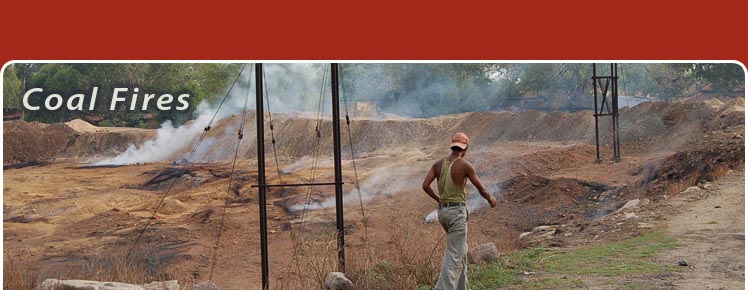

 What are coal fires?
What are coal fires?Coal, a natural non-renewal source of energy, occurs in several parts of the world as layered deposits. The coal layers or seams are mined by both opencast and underground mining methods. Coal is an organic, highly carbonaceous, material which when exposed to certain conditions (temperature, moisture, oxygen etc.) tends to ignite/combust spontaneously at rather low temperatures (visit section on spontaneous combustion). This spontaneous combustion may occur naturally or the combustion process may be trigerred by other causes. However, once a coal seam catches fire and nothing is done to stop it at an early stage, the seam may continue to burn for tens to hundreds of years, depending primarily on the availability of coal and oxygen. Such burning of naturally occurring coal is referred to in general as coal fires. In a broader sense, coal fires include surface coal seam fires, underground coal seam fires, fires in coal and carbonaceous dump material and even fire in coal being transported.
Fires may occur in coal seams that are exposed to the surface or occur close to the surface of the earth. In such cases one can often see open flames or red hot areas, which are even more spectacular in the night or pre-dawn time.
Fires may also occur in the seams occurring underground. Typically such underground fire areas are characterised by large cracks which serve as channels for oxygen to the burning coal. One may also see smoke emitting vents, burnt/baked rocks, residual sulphur encrustation, locally dry soil and barren patches and needless to say, a local rise in the surface temperature termed as a surface thermal anomaly.
Visit the coal fire photo gallery to see the pictures of the italicised features.
 Is the occurrence of coal fires actually a global problem?
Is the occurrence of coal fires actually a global problem?
Coal fires are reported from nearly all parts of the world where coal is/was mined for commercial purposes such as from coalfields in China, India, Indonesia, South Africa, U.S.A., Australia, Germany etc. However the nature and magnitude of the problem differs from country to country.
 What causes the coal reserves to start burning?
What causes the coal reserves to start burning?
Coal fires start naturally or as a result of human activities or more often due to a combination of both factors. The phenomenon of spontaneous combustion is the main natural cause of coal fires, though lightening, forest/bush fires or frictional heat generated during earth movements could also start coal fires. Among human causes are accidents, negligent acts, domestic fires, lighting fires in abandoned underground mines for heating or distilling alcohol etc.
It is worth noting that mine refuse dumps and fine carbonaceous material in the proximity of mining sites is very prone to spontaneous combustion. More often it is this loose material which first catches fire which subsequently spreads to the coal seams. Fires also travel from one coal seam to the neighbouring coal seam and from one mine to another.
 What dangers/ hazards do these fires pose?
What dangers/ hazards do these fires pose?
Besides burning away the important non renewal energy resource and causing financial losses, these fires hinder economic exploitation of coal, pose danger to man and machine, raise the temperature of the area, engulf surface features such as buildings, transportation network etc., and when present in underground are a cause of land subsidence. The pollution caused by these fires affects all the three environmental amenities, viz. air, water and land. Smoke emanating from these fires contain poisonous and obnoxious smelling gasses such as oxides and dioxides of carbon, nitrogen and sulphur which along with particulate matter are the cause of several lung and and skin diseases.